When you walk onto a car lot and look at a brand-new vehicle, the sticker on the window isn’t just decoration—it’s the Monroney label, a federally mandated document that discloses a new car’s price, features, fuel economy, and safety ratings. Also known as the window sticker, it’s your legal right to see this information before you buy. This label was created in 1958 by Senator Mike Monroney to stop dealers from hiding costs and misleading buyers. Today, it’s the single most transparent document you’ll get when shopping for a new car.
The Monroney label doesn’t just show the base price. It breaks down every optional feature—like leather seats, sunroof, or premium sound system—and lists its cost. That way, you know exactly what you’re paying for. It also shows the manufacturer’s suggested retail price (MSRP), which is the starting point for negotiation. If a dealer says a car is $30,000 but the label says $28,500, you’re being overcharged. The label also includes fuel economy numbers—city, highway, and combined MPG—based on EPA testing. That’s not marketing fluff; it’s real-world data you can trust. And if the car has an electric or hybrid powertrain, the label shows charging times, electric range, and equivalent fuel costs per mile.
It doesn’t stop there. The label lists safety ratings from the NHTSA and IIHS, so you know if the car has good crash test scores. It tells you about warranty coverage—basic, powertrain, and roadside assistance—so you’re not surprised later when something breaks. Even emissions ratings are there, which matters in states with strict environmental rules. You’ll also find the vehicle identification number (VIN), so you can cross-check the car’s history later. This isn’t just paperwork; it’s a shield against shady deals.
Some buyers ignore the label because they think it’s just a dealer’s sales tool. But it’s actually your best defense. If a salesperson says a feature is free but it’s listed as $1,200 on the label, you call them out. If they claim fuel economy is better than what’s printed, you ask for the EPA test results. The Monroney label is your proof. It’s the same for every car, so you can compare models side by side—no guessing, no tricks.
Even if you’re buying online or from a private seller, you should always ask for a copy of the Monroney label. Dealers are required to provide it. If they refuse, walk away. It’s not just a sticker—it’s your access to the truth. And when you know what’s on it, you stop being the one who gets talked into a deal and become the one who calls the shots.
Below, you’ll find real guides that help you decode what’s on the Monroney label, how to use it to negotiate better prices, and what to watch for when comparing models. Whether you’re buying your first car or upgrading to a new one, this is the information that actually matters.
Posted by
Liana Harrow
14 Comments

Learn how to read a used car's window sticker to verify features, spot lies, negotiate better prices, and avoid overpaying. The Monroney label holds the truth - if you know where to look.
read more